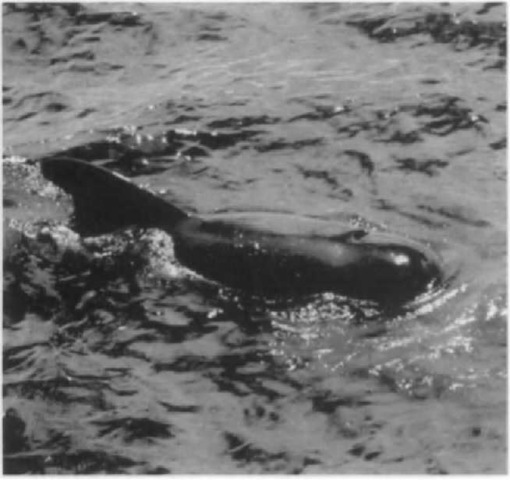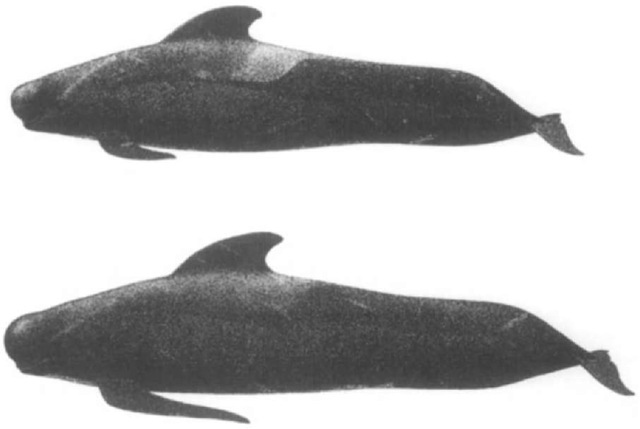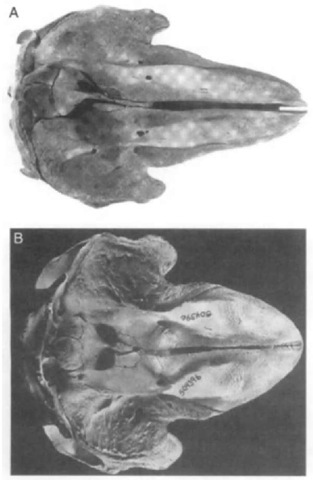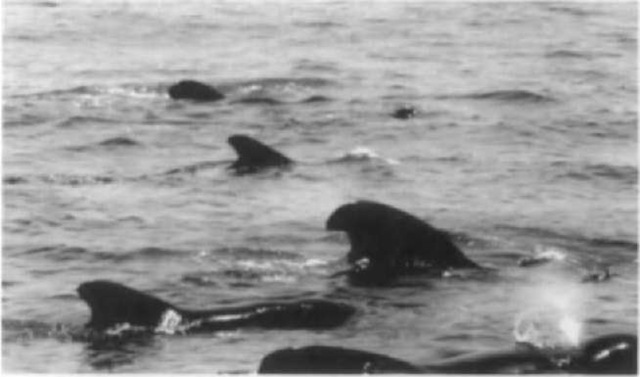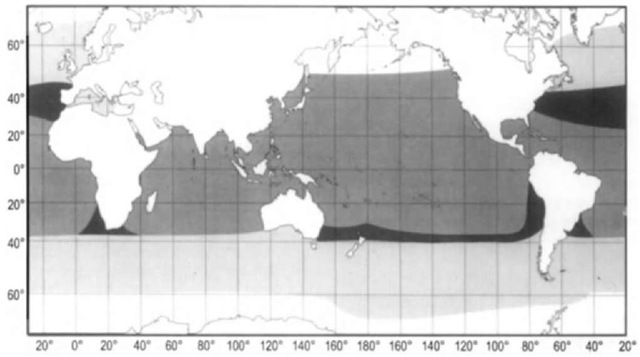Pilot whales are large dolphins, among the largest members of the family Delphinidae. They are widely distributed in the world’s oceans. Two species are recognized: Globicephala melas (long-finned pilot whale) and G. macrorhxjnchus (short-finned pilot whale). Notable aspects of pilot whale natural history include sexual dimorphism and mass strandings. Pilot whales are among the most gregarious of the cetaceans.
The name “pilot whale” originated with an early theory that a school is piloted by a leader. Other common names for these whales include pothead (after the whales’ bulbous melon) and blackfish (a term also used for melon-headed whales, pygmy killer whales, and false killer whales). The genus name, Globicephala, is derived from the Latin word globus, meaning round ball or globe, and the Greek word kephale, meaning head. Melas is a Greek word for black. Macrorhynchus is likewise derived from Greek words: macro, meaning enlarged, and rhynchus, meaning snout or beak. For many decades, malaena was used as the trivial name for the long-finned pilot whale. However, in 1986 the name was revised to melas.
I. Physiology
A. Morphology
Long-finned and short-finned pilot whales are difficult to distinguish at sea (Fig. 1). The morphological differences between the two species are subtle: length of flippers, differences in skull shape, and number of teeth. On average the pectoral flippers of long-finned pilot whales are one-fifth the body length, whereas on short-finned whales they are one-sixth the body length. However, overlap exists between the two species. Long-finned flippers exhibit a noticeable “elbow” whereas short-finned pectorals have a more curved appearance.
Adult pilot whales reach an average length of approximately 6 m. Males are larger than females. Most pilot whales appear black or dark gray in color. The body is robust with a thick tail-stock. The melon is exaggerated and bulbous, and there is either no beak or a barely discernible one. A wide, broad-based falcate dorsal fin is set well forward on the body. The flippers are long, slender, and sickle shaped. A faint gray “saddle” patch may be visible behind the dorsal fin as well as a faint postor-bital blaze (Fig. 2). A gray midventral line extends anteriorally into an anchor-shaped chest patch and widens posteriorally into a genital patch. Calves are paler than adults.
Because most size, shape, and color pattern distinctions between the two species are so variable, the shape of the skull is the only definitive characteristic for identification to species. The long-finned pilot whale has a narrower skull, with the premaxillae leaving uncovered 1 cm of the lateral borders of the maxillae (Fig. 3A). There are 9 to 12 teeth in each row. The skull of the short-finned pilot whale is shorter and broader, and the premaxillae cover the maxillae (Fig. 3B). There are 7 to 9 teeth in each row. Pilot whales have notably fewer teeth than most other del-phiniids. This is similar to the evolutionary reduction of teeth found in Risso’s dolphins (Grampus griseus) and sperm whales (Physeter ma otocephalus), two other heavy squid consumers.
Figure 1 Long-fumed and short-finned pilot whales exhibit similar external morphology, including a large, bulbous melon and a broad-based dorsal fin.
B. Sexual Dimorphism
Pilot whales exhibit striking sexual dimorphism in size, similar to that observed in sperm whales and killer whales (Orci-mis orca). Adult males are longer than females, develop a more pronounced melon, and have a much larger dorsal fin (Fig. 4). The function of sexual dimorphism in pilot whales is unknown, although several have been hypothesized. The males’ enlarged features may be used for display to other males or females or for increased agility when maneuvering for mate access or for herding females. The males’ large size may aid in defense of their school from attacks by killer whales or sharks.
C. Disease
Pilot whales in the western Atlantic have been affected by the morbilliviruses that have plagued other marine mammals in recent decades. Although to date no large-scale outbreak of disease has been reported in pilot whales, high percentages of both species sampled during the 1980s and 1990s carried virus-neutralizing antibodies. It appears that most individuals are immune. Due to their wide-ranging movements and their propensity to mix with other species, pilot whales may act as a vector for morbilliviruses in other cetaceans, such as bottlenose dolphins (Tursiops truncatus).
II. Distribution
Pilot whales are wide ranging (Fig. 5). Generally, short-finned pilot whales have a tropical and subtropical distribution and long-finned pilot whales are distributed antitropically. There is little overlap in the range of the two species. Areas of marginal overlap include the temperate waters of the North and South Atlantic, in the Pacific off the coast of Peni, and off South Africa. Pilot whales are found in both nearshore and pelagic environments.
Figure 2 Full-body view of the short-finned pilot whale (top) and the long-finned pilot whale (bottom).
Figure 3 (A) Dorsal view of the skull of a long-finned pilot whale (G. melas). (B) Dorsal view of the skull of a short-finned pilot whale (G. macrorhynchus). Note the differences in the shape and length of the rostrums and the degree to which the maxillae are covered by the premaxillae.
A. Geographical Variation and Subspecies
Long-finned pilot whales inhabit the cold temperate waters of both the North Atlantic and the Southern Ocean. The two populations are isolated. There are slight morphological differences between the populations and they are accorded subspecies status: G. melas melas in the North Atlantic and G. melas edwardii in the Southern Hemisphere.
In the North Atlantic, the range of G. melas melas includes the waters of Greenland (Denmark), Iceland, and the Barents Sea south to the Tropic of Cancer. This species is present in the western Mediterranean Sea. G. melas edwardii is circumglobal in the Southern Hemisphere, with records as far north as 14°S in the Pacific and further south than the Antarctic Convergence. Long-finned pilot whales do not occur in the North Pacific.
Short-finned pilot whales are found worldwide in tropical, subtropical, and warm temperate waters. Their northern range in the Atlantic extends to the midcoast area of the United States and to France. Short-finned pilot whales are not found in the Mediter- ranean. Latitude 25°S marks the southernmost record for the Atlantic and the Pacific coasts of South America. Elsewhere in the Pacific, the range of the short-finned pilot whale continues north to Japan and to the west coast of the United States.
Figure 4 A group of male and female pilot whales. Males are larger than females and develop exaggeratedly wide dorsal fins.
Pacific short-finned pilot whales in higher latitudes are generally larger than those in lower latitudes. Two distinct populations of short-finned pilot whales are found off northern and southern Japan. These populations exhibit morphological differences in external and cranial features. The populations are segregated geographically and genetically. However, their exact taxonomic status is still undetermined and for the time being they are both classified as G. macrorhynchus.
B. Abundance
Estimates of abundance for pilot whales have generally been undertaken in response to management issues. Survey areas are typically determined by management goals rather than natural population boundaries. Most of the quantitatively derived estimates of abundance are for nearshore populations. Estimates using line-transect methods have been made for Newfoundland/Labrador (Canada), the northeast Atlantic, the Antarctic, the U.S. West Coast, northern and southern Japan, and the eastern tropical Pacific (Table I).
III. Fossil Record
The extant delphinid groups (to which Globicephala belongs) appeared in the Middle to Late Miocene Epoch. Fossils of the genus Globicephala dating from the Pleistocene Epoch have been uncovered in Florida (G. baerreckeii). Odontocete remains from the Pliocene Epoch uncovered in Tuscany, Italy, have been designated as Gobicephala? eturiae.
Although the long-finned pilot whale does not currently inhabit the North Pacific, skulls dated to the 8th to 12th centuries have been recovered in Japan. Short-finned pilot whales now inhabit those waters.
IV. Ecology
Pilot whales are found on the continental shelf break, in slope waters, and in areas of high topographic relief. In general, pilot whales are nomadic, but resident populations have been documented in a few locations such as coastal California and Hawaii. Seasonal inshore/offshore movements of pilot whales are related to the distribution of squid, their favorite prey. Studies in Newfoundland and California correlated the seasonal abundance of pilot whales with spawning squid.
Figure 5 Worldwide distribution of pilot whales. The distribution of long-finned pilot whales is indicated by light shading and the distribution of short-finned pilot whales by medium shading. Dark shading indicates regions where the species overlap.
The pilot whale diet consists primarily of squid, with lesser amounts offish. Fish prey in the northwest Atlantic include Atlantic cod (Gadus morhua). Greenland turbot (Rheinhardtius hippoglossoides), Atlantic mackerel (Scomber scombris), Atlantic herring (Clupea harengus), hake (Urophycis spp.), silver hake (Merluccius bilinearis), and spiny dogfish (Squalus acan-thias). Pilot whales in the northeast Atlantic have been known to take Atlantic Argentine (Argentina silus) and blue whiting (Micromesistius poittassou).
The ecosystem changes brought about by a strong El Nino event in 1982-1983 affected the distribution of pilot whales off southern California dramatically. With the influx of warm water during the El Nino, squid did not spawn as usual in the area. Pilot whales were virtually absent from the region that year and remained so for another 9 years. It is not known where the whales went during this time or whether the whales sighted there now are returning or are new individuals.
V. Life History
Pilot whales share several features of life history with other large odontocetes: long life span, delayed maturity, different rates of maturation for males and females, seasonal mating, and the production of a single calf in multiyear intervals.
TABLE I
Estimates of Pilol Whale Abundance Using Line-TYansecl Melhods
|
Spccies/Subspccics Globicephala inelas melas |
Area Newfoundland/Labrador |
Population 6.731-19,603 |
|
G. melas inelas |
Northeast Atlantic |
778.000 |
|
G. melas edwardii |
Antarctic |
200,000 |
|
G. macrorhynchus |
West coast U.S. |
970 |
|
G. macrorhynchus |
Northern Japan |
5,300 |
|
G. macrorhynchus |
Southern Japan |
53,000 |
|
G. macrorhynchus |
Eastern tropical Pacific |
160.200 |
Short-finned pilot whales have a slower growth rate than long-finned pilot whales and reach a shorter body length. The pattern of growth for both species is similar. Rapid neonatal growth is followed by a less rapid but continual growth phase during the juvenile years. Growth slows even further after the attainment of sexual maturity and ceases some years later. Short-finned females become sexually mature at 9 years, males at age 13 to 16. Long-finned females reach sexual maturity at 8 years, males at about 12. Males become socially mature, e.g., mate successfully, several years after reaching sexual maturity.
In the Northern Hemisphere, mating generally occurs in spring or early summer and parturition in summer or early autumn. An exception to this is the population of pilot whales off northern Japan. Their peak breeding season is autumn with parturition in winter. Gestation is estimated to be 12 months for long-finned pilot whales and 15-16 months for short-finned whales.
interval in pilot whales is one of the longest of all the cetaceans. Lactation lasts for at least 3 years, often longer. Such an extended lactation The birth period probably serves a social rather than nutritional purpose in later years. The capability of a short-finned female to lactate years past final ovulation has been reported. This supports the theory that females may invest more in present offspring as their likelihood to bear more offspring diminishes. Sizable numbers of postreproductive females have been found in populations of both species.
Estimates of natural mortality for pilot whales are based on data from the directed fisheries in the Faeroe Islands (Denmark) and Japan. These data indicate that male pilot whales have a higher mortality rate at all ages than those of females. Females are known to be longer-lived. Females live past 60 years; males reach 35-45 years.
VI. Behavior
A. Social Organization
Pilot whales are highly social and are usually found in schools, or pods, averaging 20-90 individuals. A variety of group behaviors have been documented. Commonly reported are traveling or foraging in a loose chorus-line formation or collective logging at the surface.
The social structure of pilot whale pods is similar to that of killer whales. Pilot whales form stable pods composed of individuals with close matrilineal associations. All age and sex classes are included, although there is a female bias in adults. The groups are stable; pilot whales grow to maturity in their natal group and most remain there for life. Genetic evidence supports the theory that males breed outside their family group.
Pilot whales are polygynous. Huge aggregations of pilot whales are occasionally reported and it is believed that males move between family groups to mate during these temporary aggregations. This type of social structure where adult males stay with their female kin and mate elsewhere is unusual among mammals.
B. Sound Production
Pilot whales echolocate with a precision similar to that of bottlenose dolphins. Pilot whales also vocalize, the primary purpose probably being to maintain contact among school members. Vocalizations are more complex with active behavior and simpler with calmer behavior.
Significant differences have been found between the calls of long-finned and short-finned pilot whales. The calls of long-finned pilot whales are of a lower frequency and a narrower frequency range than those of short-finned pilot whales. The mean frequency for long-finned pilot whales is 4480 Hz, for short-finned pilot whales the mean frequency is 7870. Short-finned pilot whales were also found to have distinct group-specific call repertoires, as would be expected for a species with stable matrilineal kinship groups.
C. Interspecific Associations
Pilot whales are often observed in mixed species aggregations. They are most commonly sighted in association with common bottlenose dolphins (Tursiops truncatus), but have also been seen with short-beaked common dolphins (Delphinus delphis), Atlantic white-sided dolphins (Lagenorhynchus acutus), Pacific white-sided dolphins (Lagenorhynchus obliq-uidens), striped dolphins (Stenella coemleoalba), Fraser’s dolphins (Lagenodelphis hosei) killer whales, fin whales (Balaenoptera physalus), sperm whales, and gray whales (Eschrichtius robustus). There are accounts of pilot whales behaving aggressively toward humpbacks (Megaptera novaean-gliae), sperm whales, common dolphins, and dolphins of the genus Stenella. Pilot whales have also been reported carrying the carcasses of dead California sea lions (Zalophus californi-anus) and towing a human diver.
D. Mass Stranding
Pilot whales are one of the most frequently reported cetaceans in mass strandings. Strandings of pilot whales are dramatic events because they usually involve groups of animals and because live whales that are assisted back into the ocean often return to the beach. Pilot whales strand singly as well as in groups; often these animals are diseased.
Curiously, most of the whales in a group event do not show any pathology. It is not known why apparently healthy animals strand, although there are a variety of hypotheses. The whales may become confused or trapped in shallow areas; geomagnetic anomalies may disorient whales if they are using the earth’s magnetic field for navigation; or if an ill animal strands it may be followed by members of its pod. The strong social bonds within a pilot whale pod are likely to play a role in stranding events, whatever the other underlying reasons may be.
VII. Interactions with Humans
A. Directed Catches
Because of their cohesive social structure, pilot whales are susceptible to herding by humans. Meat, blubber, and oil are the desired products. Historically, there have been a number of directed fisheries for pilot whales. In the North Atlantic, drive fisheries for long-finned pilot whales were conducted in Newfoundland, Cape Cod, Norway, Iceland, Orkney Islands (Scotland), Hebrides Islands (Scotland), Greenland, and the Faeroe Islands. The intensive drive fishery in Newfoundland (1947-1971) is estimated to have taken 54,000 animals and to have reduced the local population substantially. The population may be recovering, but more information is needed. Fisheries for short-finned pilot whales have operated in the Caribbean and in Japan.
The drive fishery in the Faeroe Islands and the drive and harpoon fisheries in Japan continue today. These fisheries have been in existence for several hundred years. In 1996, the catch of long-finned pilot whales in the Faeroes was 1524 animals; in 1997, Japan reported a catch of 347 short-finned pilot whales.
B. Bycatch
The incidental bycatch of cetaceans in fisheries is a worldwide phenomenon. Most bycatch goes unreported because this information is not recorded in many countries. Pilot whales are particularly susceptible to entanglement in driftnets. The effect of such mortality on pilot whale populations is unknown.
In northeast U.S. waters, pilot whales have been taken incidentally in a variety of fisheries: mackerel and squid trawls, pelagic drift gill nets, pelagic long lines, and pelagic pair trawls. Some of these fisheries are now closed, and none of the current fisheries exceed the allowable annual take for pilot whales under U.S. law.
Pilot whales off California and Mexico are taken incidental to driftnet fisheries targeting swordfish and sharks. It is likely that these takes are from the same population of short-finned pilot whales, and the per-set mortality rate reported from both countries is similar. In the United States the take exceeds the allowable annual limit and a take reduction plan has been implemented. Prior to the El Nino of 1982-1983, pilot whales were taken incidentally in the Californian squid purse seine fishery. Pilot whale redistribution in response to El Nino is the likely reason no mortality was reported for this fishery during the following years. Currently the squid fishery is not monitored, but there have been anecdotal reports of pilot whales seen near squid fishing operations in recent years.
C. Contaminants
Long-finned pilot whales from both sides of the north Atlantic carry high levels of organochlorine contaminants (pesticides such as DDT and PCB) in their tissues. Concentrated organochlorines may impair reproduction or increase susceptibility to disease. Studies are continuing on the effects these compounds have on marine mammals.
Accumulations of cadmium and mercury are also present in the tissues of long-finned pilot whales from the Faeroe Islands. As top predators, pilot whales are a repository of these heavy metals accumulating through the marine food chain. Pilot whales seem unusually tolerant to elevated levels of these metals, as studies have not yet revealed a major toxicity problem in these species.
D. Captivity
Numerous short-finned pilot whales have been captured for training and/or display in the United States and other parts of the world. Whales have been taken from northeast United States, California, Hawaii, and Japan by means of direct capture, incidental to drive fisheries, or stranding salvage. The most recently published North American marine mammal display census dates from 1990. At that time, four pilot whales were on exhibit in United States and Canadian aquaria. Stranded pilot whales have occasionally been kept for rehabilitation and subsequently released.
